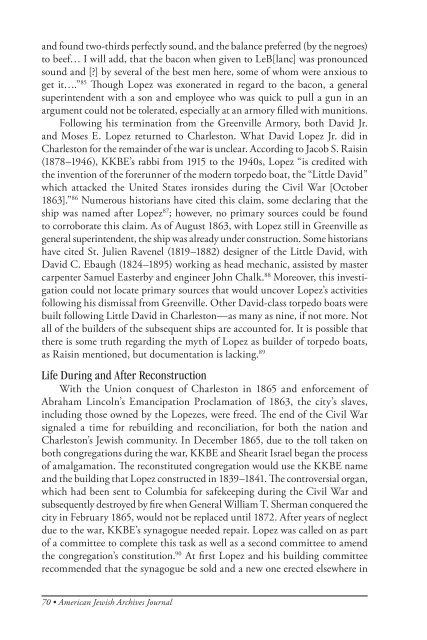American Jewish Archives Journal, Volume 64, Numbers 1 & 2
American Jewish Archives Journal, Volume 64, Numbers 1 & 2
American Jewish Archives Journal, Volume 64, Numbers 1 & 2
Create successful ePaper yourself
Turn your PDF publications into a flip-book with our unique Google optimized e-Paper software.
and found two-thirds perfectly sound, and the balance preferred (by the negroes)<br />
to beef… I will add, that the bacon when given to LeB[lanc] was pronounced<br />
sound and [?] by several of the best men here, some of whom were anxious to<br />
get it….” 85 Though Lopez was exonerated in regard to the bacon, a general<br />
superintendent with a son and employee who was quick to pull a gun in an<br />
argument could not be tolerated, especially at an armory filled with munitions.<br />
Following his termination from the Greenville Armory, both David Jr.<br />
and Moses E. Lopez returned to Charleston. What David Lopez Jr. did in<br />
Charleston for the remainder of the war is unclear. According to Jacob S. Raisin<br />
(1878–1946), KKBE’s rabbi from 1915 to the 1940s, Lopez “is credited with<br />
the invention of the forerunner of the modern torpedo boat, the “Little David”<br />
which attacked the United States ironsides during the Civil War [October<br />
1863].” 86 Numerous historians have cited this claim, some declaring that the<br />
ship was named after Lopez 87 ; however, no primary sources could be found<br />
to corroborate this claim. As of August 1863, with Lopez still in Greenville as<br />
general superintendent, the ship was already under construction. Some historians<br />
have cited St. Julien Ravenel (1819–1882) designer of the Little David, with<br />
David C. Ebaugh (1824–1895) working as head mechanic, assisted by master<br />
carpenter Samuel Easterby and engineer John Chalk. 88 Moreover, this investigation<br />
could not locate primary sources that would uncover Lopez’s activities<br />
following his dismissal from Greenville. Other David-class torpedo boats were<br />
built following Little David in Charleston—as many as nine, if not more. Not<br />
all of the builders of the subsequent ships are accounted for. It is possible that<br />
there is some truth regarding the myth of Lopez as builder of torpedo boats,<br />
as Raisin mentioned, but documentation is lacking. 89<br />
Life During and After Reconstruction<br />
With the Union conquest of Charleston in 1865 and enforcement of<br />
Abraham Lincoln’s Emancipation Proclamation of 1863, the city’s slaves,<br />
including those owned by the Lopezes, were freed. The end of the Civil War<br />
signaled a time for rebuilding and reconciliation, for both the nation and<br />
Charleston’s <strong>Jewish</strong> community. In December 1865, due to the toll taken on<br />
both congregations during the war, KKBE and Shearit Israel began the process<br />
of amalgamation. The reconstituted congregation would use the KKBE name<br />
and the building that Lopez constructed in 1839–1841. The controversial organ,<br />
which had been sent to Columbia for safekeeping during the Civil War and<br />
subsequently destroyed by fire when General William T. Sherman conquered the<br />
city in February 1865, would not be replaced until 1872. After years of neglect<br />
due to the war, KKBE’s synagogue needed repair. Lopez was called on as part<br />
of a committee to complete this task as well as a second committee to amend<br />
the congregation’s constitution. 90 At first Lopez and his building committee<br />
recommended that the synagogue be sold and a new one erected elsewhere in<br />
70 • <strong>American</strong> <strong>Jewish</strong> <strong>Archives</strong> <strong>Journal</strong>
















